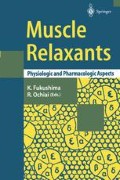Abstract
Two main groups of neuromuscular blocking drugs are available for use in the Intensive Therapy Unit (ITU): the aminosteroids and the benzylisoquinolinium compounds. These drugs are occasionally used in such patients in addition to analgesics and sedatives, to manage patients undergoing artificial ventilation. They are given not only to effect tracheal intubation, gastroscopy, bronchoscopy, etc., but also in the continued management of the critically ill.
Access this chapter
Tax calculation will be finalised at checkout
Purchases are for personal use only
Preview
Unable to display preview. Download preview PDF.
References
Van Miert M.M., Hunter J.M. (1994). Neuromuscular blocKing agents in critically ill patients. Current Opinion in Anaesthesiology. 7, 394–9.
Zochodne D.W., Bolton F., Wells G.A., Gilbert J.J., Hahn A.F., Brown J.D., Sibbald W.A. (1987). Critical illness polyneuropathy. A complication of sepsis and multiple organ failure. Brain. 110, 819–42.
Horton W.A., Ferguson N.V. (1988). Hyperkalaemia and cardiac arrest after the use of suxamethonium in intensive care. Anaesthesia. 43, 890–1.
Segredo V., Caldwell J.E., Matthay M.A., Sharma M.L., Gruenke L.D., Miller R.D. (1992). Persistent paralysis in critically ill patients after long-term administration of vecuronium. New England Journal of Medicine. 327, 524–8.
Vandenbrom R.H.G., Wierda J.M.K.H. (1988). Pancuronium bromide in the intensive care unit: a case of overdose. Anesthesiology. 69, 996–7.
Hansen-Flaschen J., Cowen J., Raps E.P. (1993). Neuromuscular blockade in the intensive care unit: more than we bargained for. American Review of Respiratory Diseases. 147, 234–6.
Meyer K.C., Prielipp R.C., Grossman J.E., Coursin D.B. (1994). Prolonged weakness after infusion of atracurium in two intensive care unit patients. Anesthesia and Analgesia. 78, 772–4.
Griffiths R.B., Hunter J.M., Jones R.S. (1986). Atracurium infusions in patients with renal failure on an ITU. Anaesthesia. 41, 375–81.
Parker C.J.R., Jones J.E., Hunter J.M. (1988). Disposition of infusions of atracurium and its metabolite, laudanosine, in patients in renal and respiratory failure in an ITU. British Journal of Anaesthesia. 61, 531–40.
Parker C.J.R., Hunter J.M. (1989). Pharmacokinetics of atracurium and laudanosine in patients with hepatic cirrhosis. British Journal of Anaesthesia. 62, 177–83.
Shi W-Z, Fahey M.R., Fisher D.M., Miller R.D. (1989). Modification of central nervous system effects of laudanosine by inhalational anaesthetics. British Journal of Anaesthesia. 63, 598–600.
Fahey M.R., Rupp S.M., Canfell P.C., Fisher D.M., Miller R.D., Sharma M., Castagnoli K., Hennis P.J. (1985). Effect of renal failure on laudanosine excretion in man. British Journal of Anaesthesia. 57, 1049–51.
Yate P.M., Flynn P.J., Arnold R.W., Weatherley B.C., Simmonds R.J., Dopson J. (1987). Clinical experience and plasma laudanosine concentrations during atracurium infusion in the intensive therapy unit. British Journal of Anaesthesia. 59, 211–7.
Gwinnutt C.L., Eddleston J.M., Edwards D., Pollard B.J. (1990). Concentrations of atracurium and laudanosine in cerebrospinal fluid and plasma in three intensive care patients. British Journal of Anaesthesia. 65, 829–32.
Tsui D., Graham G.G., Torda T.A. (1987). The pharmacokinetics of atracurium isomers in vitro and in humans. Anesthesiology. 67, 722–8.
Stone A.J., Pollard B.J., Harper N.J.N. (1994). Infusion requirements of patients receiving 51W89 in the intensive care unit. British Journal of Anaesthesia. 72, 486P–7P.
Coursin D., Murray M., Scuderi P., Prough D., Abou-Donia M., Miller D. (1993). An evaluation of doxacurium and pancuronium in a multi-center, randomised, double-blind study in the critically ill. Critical Care Medicine. 21, S263.
Author information
Authors and Affiliations
Editor information
Editors and Affiliations
Rights and permissions
Copyright information
© 1995 Springer Japan
About this paper
Cite this paper
Hunter, J.M. (1995). Benzylisoquinolinium Compounds in the Critically Ill Patient. In: Fukushima, K., Ochiai, R. (eds) Muscle Relaxants. Springer, Tokyo. https://doi.org/10.1007/978-4-431-66896-1_24
Download citation
DOI: https://doi.org/10.1007/978-4-431-66896-1_24
Publisher Name: Springer, Tokyo
Print ISBN: 978-4-431-66898-5
Online ISBN: 978-4-431-66896-1
eBook Packages: Springer Book Archive

